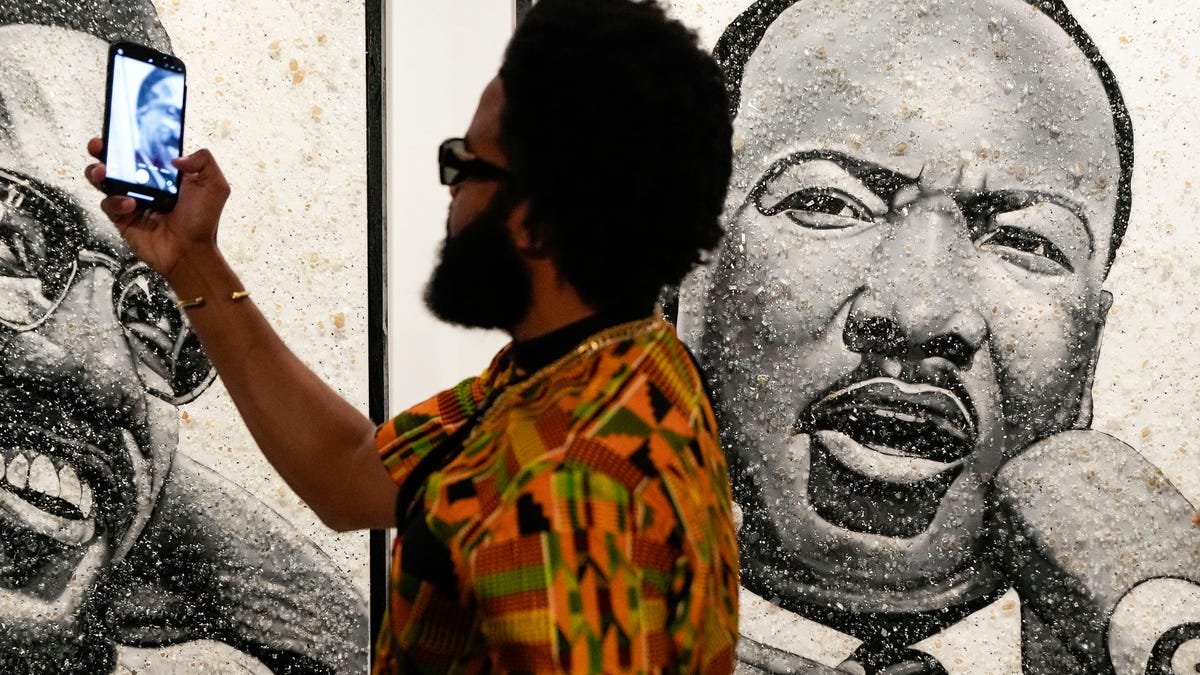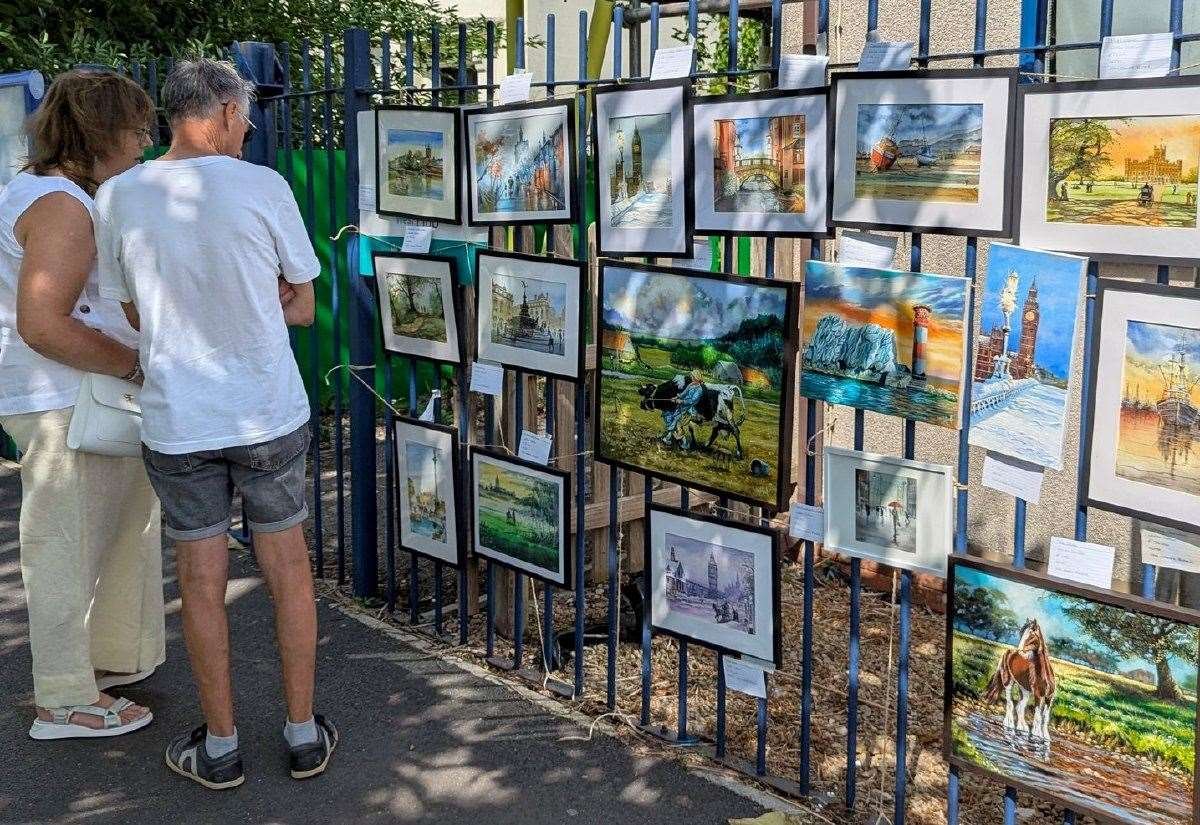On June 8, when Kristian “Nu Element” Rodriguez heard that some of his fellow local artists were on their way to the Brick By Brick street art festival, the short notice didn’t matter. He knew he had to join them.
When he arrived at the festival — at the at the Summit Lounge alleyway connecting Water and Harding Streets near Kelley Square — it turned out he had nothing to worry about. Other artists cleared a section of brick wall and lent him spray cans, and soon, he was hard at work, mixing colors and teaching his craft to his young daughter.
“I didn’t have any paint at all, I barely had a spot to paint, but we cut some vines and I had a nice little wall,” Rodriguez said. “It was especially cool to have my daughter paint because it was her first time picking up a spray can.”
‘We had the best of the best’
Artifakt Studios, responsible for many of the murals and art installations that decorate Worcester’s businesses, brought in more than 25 graffiti and mural artists to cover the walls of the alleyway near Kelley Square over the course of five days for the Brick By Brick festival.
Co-founder Audrey Tesserot said the festival felt something like a continuous party, with different artists dropping in each day to add their pieces to the puzzle.
“We had the best of the best, some people who have been painting this way for more than 20 years – some OGs. We had people come from all over regionally to paint on these walls,” Tesserot said. “Every single day, there was a collective hum of all of us being there for a shared purpose and pushing each other to do better in our creative art form.”
Filling ‘a void of street art festivals’
Artifakt Studios held its first street art festival last summer as part of a July block party near its Tatnuck Square location. Over the course of that afternoon, artists took part in a “wall jam,” which filled the outdoor walls of two buildings.
Tesserot said the wall jam, and the response it got from local artists, inspired her and co-founder Ryan Gardell to put on this year’s Brick By Brick festival and bring the same spirit to a different part of town.
“There’s been a void for street art festivals in Worcester over the last few years,” Tesserot said. “We had our initial festival last year, and it’s easier to do it in our neighborhood, but we wanted to stretch what’s possible and spread street art into more parts of the city in order to share our work, make a statement, and add a little bit of color.”
The past decade has seen bright colors cover many of downtown Worcester’s walls, mostly through the Pow! Wow! Worcester mural program, which has brought in artists from all over the country and all over the world.
Closing a gap
Artifakt Studios has also had a hand in the decorating of Worcester’s buildings. Gardell’s prolific work includes iconic Red Sox moments and Canal District historical figures on walls near Polar Park, as well as a sunset scene above the playground outside Department of Children and Families’ Worcester office.
Tesserot said Artifakt Studios hopes to create a positive and inclusive space between reactions to high-profile mural projects, such as those included in Pow! Wow! Worcester, and mixed attitudes towards the city’s grassroots and sometimes law-breaking graffiti culture.
Tesserot said she deliberately refers to Artifakt Studio’s work as street art, rather than murals, because the term encompasses different forms of wall art without upholding one at the expense of another.
“The reason I use street art as a term is because it groups murals and graffiti into the same category. They are all one and the same,” Tesserot said. “Graffiti also encompasses murals. There are plenty of murals within graffiti, and there’s plenty of graffiti that can be seen within murals. Our job is to bring light to this and dispel these myths that graffiti is just vandalism or ugly tags.”
In the case of the Brick by Brick festival, the effort was done legally and in compliance with the city’s requirements, said Gardell, who said he curated the artists with thoughtfulness.
Artists such as Rodriguez have been bringing their spray cans and knowledge of color theory throughout Worcester for much longer. However, both Rodriguez and Tesserot said graffiti, no matter how meaningful or pleasing to the eye, doesn’t get the respect it deserves.
“People hear the word ‘graffiti’ and think of vandalism, young kids writing on Dumpsters and on walls. Beautiful graffiti makes you sit back and think, ‘Wow, whoever did that must have put a lot of time and thought into it,’” Rodriguez said. “There’s theory and dimensions and a lot more that goes into it.”
Dispelling myths about murals
Tesserot said she deliberately refers to Artifakt Studio’s work as street art, rather than murals, because the term encompasses different forms of wall art without upholding one at the expense of another.
“The reason I use street art as a term is because it groups murals and graffiti into the same category. They are all one and the same,” Tesserot said. “Graffiti also encompasses murals. There are plenty of murals within graffiti, and there’s plenty of graffiti that can be seen within murals. Our job is to bring light to this and dispel these myths that graffiti is just vandalism or ugly tags.”
In Tesserot’s opinion, the only distinction between graffiti and other visual art is the way it is treated.
“If something is inside an art gallery and you pay to walk in the door and see it, you may or may not like it, but you’re not going to call the police. You’re going to respect it for what it is, and take it or leave it,” Tesserot said.”I was literally approached by the business owner to paint this building,” he says, “but he had no funding.” Gardell says the money for paints and supplies were raised from a $5,000 Worcester Arts Council grant, and Artifakt sponsored the rest, including things such as ladders and the LLC’s insurance.
Gardell describes the state of the alley before the project as “a typical bar urinal. Trash was on the ground … People would go there to use drugs, or drink nips and throw then on the ground. These spaces are often used for less than scrupulous activities. We took a sketchy alley and made it more inviting and safer of people to walk through.”
Creating positive activity
“When we first started the project,” says Gardell, “We had a lot of activity. People sleeping in the alleyway. They would talk to us and they weren’t thrilled by our presence, but they didn’t cause us any animosity. They just moved somewhere else.
Gardell express some sadness at that, saying that “the goal was not to displace people. It’s just to create more positive activity.
Gardell said by painting they alleyway, he hopes people are moved to respect the space more, that the alley becomes a destination for locals to take pictures, selfies and photoshoots.
Still, Gardell insists on maintaining the anonymity of the artists who contributed to the project, in part because that’s inherent to the the culture of the artform, and in part because he fears the the artists being subjected to pushback from people who feel the art form is a negative, even criminal activity.
“I’m taking accountability here,” says Gardell. “I don’t when them to have to deal with any of it,” although he admits doubts that any of the artists that participated would be overly concerned. Still, he’s cognizant of the stigma that sometimes comes with the art form.
“As a street artist,” says Gardell, “I fall under the same stereotype and stigma that a lot of these artists do. Because we use spray paint, graffiti is seen as a lowbrow art form, lesser than someone painting with a brush. It gets connected to vandalism, destructive tendencies and gang culture,” negative stereotypes which, in reality, the art form has long moved past.
A safe place to paint
Rodriguez, who also produces music. grew up steeped in hip-hop culture as the son of a Worcester rapper. He first picked up a can of paint at 13 years old, inspired by graffiti’s position as one of the culture’s four pillars.
For a decade, he painted at the Worcide Community Skatepark, which welcomed graffiti as an expression of city creativity. But in 2018, the city demolished the skate park on the grounds that the nearby homeless population was leaving trash that constituted a public safety hazard.
Since Worcide met its end, Rodriguez said, Worcester graffiti artists have been without a space to legally hone their craft, and he hoped Worcester would carve out a space like Cambridge’s Graffiti Alley, where the walls are specifically set aside to be painted.
“When we don’t have murals, we’ve got to resort to painting trains, and it’s not the safest thing to do,” Rodriguez said. “If there are spaces for people to paint, the city won’t have a big problem with it. It would be nice to have a public space where people can go paint and don’t have to worry about being on anyone’s property.”
Tesserot said on an average walk through Worcester, she can’t help but notice every blank wall that could someday be home to a brightly-colored piece of art.
“Whenever we see walls like this that are beautiful, bare brick in great condition, it’s an amazing canvas that could have beautiful art on it if someone would allow that to happen,” Tesserot said.
The artwork from the Brick by Brick festival can be seen at the Summit Lounge alleyway connecting Water and Harding Streets. The Summit Lounge is located at 116 Water St., Worcester. For more information, see the wall part page at artifaktstudios.com.
Victor D. Infante contributed to this article.






